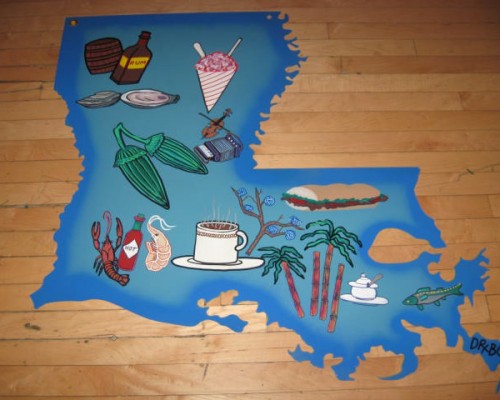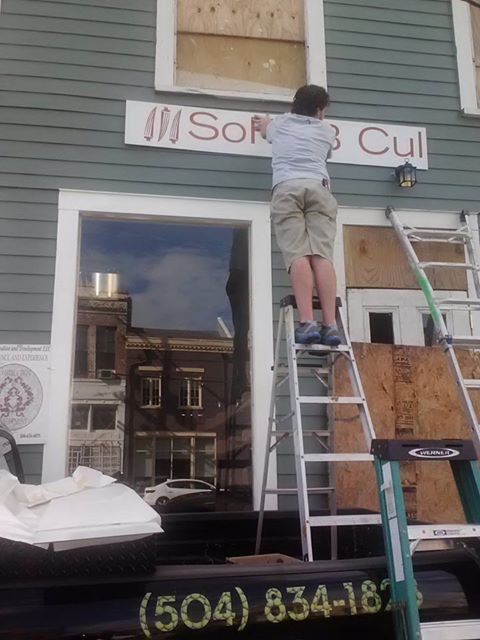by Nico Rosario
On a perfect Indian summer morning, I sat down with Liz Williams, President and Director of the Southern Food and Beverage Museum (SoFAB) in New Orleans. Over donuts and chai at the Doughnut Plant in the Lower East Side, we chatted about food traditions, the southern food diaspora, and SoFAB’s new culinary library, which opens to the public on October 30th.
Nico Rosario: With today being 9/11 and New York still reeling from the effects of Hurricane Sandy, I was thinking about how people rebound from catastrophic events like these, an immediate comparison being Hurricane Katrina. One of the positive responses to 9/11 was the founding of the Tribeca Film Festival, for instance, which transformed that neighborhood and brought people back downtown. Have you noticed a similar transformation in New Orleans?
Liz Williams: Absolutely! Before 2005, which was the year of Hurricane Katrina, food was still a part of our identity in New Orleans, but there was also what I guess would be a normal homogenization going on. For example, when I was a child, a Subway sandwich shop could never have opened in New Orleans because why would you eat at Subway when you could eat a po’ boy? But by 2005 there was enough advertising on TV and other media that people were willing to accept a Subway or a Quiznos next to a po’ boy shop. They might actually choose Subway instead of a po’ boy. Not to say that New Orleans food was going away, but it wasn’t so central anymore to identity. After Katrina, 80% of the city was destroyed—that’s a huge percentage. You had this diaspora of people going all over the place because the city was closed down. [SoFAB] started getting emails asking, “Where can I get this kind of red bean?” or “Where can I get filé at the grocery store, because I’m in Minneapolis or Seattle or Memphis and I can’t find these things?” Well, because you’re not going to find those kinds of things there, no matter what. They’re just not there.
NR: I had a similar thing happen when I lived in Berlin in 2010. There was an ex-pat who’d opened a New Orleans-style restaurant and he was saying the same thing; he couldn’t get exactly what he needed and so he was getting some of it imported from the U.S. and otherwise doing the best with what he had. And I remember him saying that if he’d had different materials, he could do different things but this was the closest he was going to get and that was better than nothing.
LW: This reminds me of a story that sounds like it could be urban legend, but I think it’s actually true. There was a shelter set up in Houston for displaced New Orleanians after Katrina. Some church groups were bringing prepared foods to the shelter, but the food was so bad that the people living in the shelter couldn’t eat it! Because they had a kitchen, they requested that the food just be brought to them raw so they could cook it themselves. And they started making stewed chicken and gumbo and red beans and rice and coffee and chicory, things that people in Houston were not used to eating. But it made them feel better, because it made them feel more at home.
It was 60-90 days before people started to return home, and still only 20% percent of the city was really able to move back. You’d have people come in for the day to work on their houses but most of the kitchens were destroyed. You started to hear about refrigerator cemeteries…
NR: What’s a refrigerator cemetery?
LW: Well, there was no electricity and with the refrigerator door shut, all our refrigerators were toxic. It was just disgusting. People didn’t even open them, they just duck-taped around them and put them out on the street. You don’t realize that the seams in your refrigerator are not absolutely impervious. And so this liquid yuck would seep in between the walls and be absorbed in the insulation—there was no getting it out. It was putrid; you just could not use those refrigerators. We all had trouble with our insurance companies; they were saying that our refrigerators were still functioning and they wouldn’t replace them. They finally came around, but it was interesting because no one’s refrigerator goes through this normally.
NR: It’s weird during times of trauma, the things that you don’t think about, stupid things that you should think about, like what happens when you live on the 17th floor of a building and you lose your electricity and water for a week?
LW: Exactly. And at some point you have to leave your apartment and go somewhere but where are you going to go? Because everything around you is in the same boat…
NR: So what have you been doing with yourself while in NYC?
LW: One of the things I did was visit the New York Public Library’s exhibit “The ABC of It: Why Children’s Books Matter.” The reason I did that was because we will be opening our stand-alone culinary library and archive on October 30. Although we have nothing compared to what you have here—we only have about 12,000 volumes—there is no culinary library in the area. One of the things we decided to specialize, or make our mark in, was children’s culinary literature.
It’s a partnership with the New Orleans Public Library. They have researched it, and we are the only culinary library not associated with a culinary school, a university, or a large food corporation. We’re also the only culinary library that is a branch of a public library. We’re very, very excited!
NR: One of my favorite food experiences in New Orleans was going to Versailles, Eastern New Orleans’ Vietnamese neighborhood, and eating pho and bánh mì with my sister. My sister said, “Who would think there’d be good Vietnamese food in New Orleans?” And I told her that the only reason I knew about that neighborhood was because I’d made a Swedish friend while living in Berlin who had just moved there from New Orleans and that was one of the only foodie things she’d suggested. So I guess New Orleans isn’t just about Cajun food…
LW: Ooh! No, it’s not Cajun at all. In fact, if you’re from New Orleans, people get very upset if you talk about Cajun food because New Orleans food is not Cajun. It wasn’t until the World’s Fair in 1984 that Cajun food had even touched New Orleans. And people don’t realize that because it doesn’t seem that long ago; it seems like it’s been around forever. But when I was growing up, you never ate Cajun food unless you left and went to Cajun Country. Creole (which was New Orleans food) and Cajun were not the same. They are not the same. Anyway, during the World’s Fair, there was a large food pavilion with food from all over the state of Louisiana. The food writers who were there, for like 3 days or whatever, hadn’t traveled around the whole state; they just went to the World’s Fair. There’d be a crab boil or étouffee stand next to a red beans and rice stand, next to something else. The writers didn’t know the difference, or get that this food came from one part of the state and that food was from somewhere else. Consequently, all the articles that came out described Creole/Cajun food as one thing. So you’re in Des Moines and you don’t know the difference…
NR: Or New York! (pointing at myself)
LW: (Laughing) Or New York! And food writers (who are supposed to know everything) are writing about this and therefore you expect to get Cajun food in New Orleans. But you couldn’t. Tourists would come to New Orleans and ask for Cajun food and the locals would say, “You can’t get Cajun food here; you have to go to Lafayette.” And the tourists would say, “But I read this article…” So the restaurants began to serve Cajun food. But if you’re from New Orleans, you know the difference and you know those two things don’t go together, at all.
NR: But in my mind, they totally go together.
LW: Exactly! But what’s interesting is that after Katrina, when restaurants started to reopen, you would go out to eat after sloshing through the mess in your house all day, and sit around with other people. You were brought together by the food and the experience of the mess you were in. And it made it feel like you were home again because everything had felt so isolated. What that also meant was that all those Subways and homogenized fast food places didn’t come back, because our demographics no longer supported them. What came back was this great opportunity for all the Mom-and-Pops to reopen and they were doing really well. People chose to eat food to memorialize their identity, because they could. It was a reminder that we’d almost lost this. All the restaurants that were reopening were like a sign that the soul of the city was still there. And that was really important.
NR: That is really important because New York City, for instance, doesn’t have a ”New York City” cuisine; we have a lot of New York City cuisines. I don’t want to glamourize the South as being limited to this but Memphis, New Orleans… have specific types of food. Or I guess even Miami. Actually, now that I’m saying that, I wonder: do you consider Florida “the South?” I feel like there’s always a debate going about whether Florida counts as “the South.”
LW: We decided that the South is purely geographic so we’re saying that the influences, and really the Gulf Coast—Florida, Alabama, Mississippi, Louisiana, and Texas—shares so much, there’d be no way you couldn’t include Florida in there. All the food that spawns in the Gulf and then goes around the tip of Florida and into the Atlantic is really important. In fact, I want to include Puerto Rico in what we call “South” because we’re just connecting it geographically; we’re not saying that everything necessarily connects, but I know that all the things that happen in the Caribbean are very related to the South. Even if it’s just one step removed, there’s still an influence there, even if it’s not obvious. I think in New Orleans, it’s obvious.
We intend to organize the museum geographically. We plan to paint a highway map of the South on the floor so that people can find the state that they wish to examine. But there will not be hard walls between the states, because food does not recognize political boundaries. We’ll have paper maps of the barbecue trail through the museum. People will be able to see how barbecue is different in different states. Corn is also used differently around the South. Beans and rice, too.
We’re also going to have a demonstration kitchen and a restaurant that will be part of the exhibit. We will allow people to eat and drink while in the museum. We don’t plan to restrict that portion of the food and drink experience!
The influence of immigrants on the cuisine of New Orleans is fascinating. The Vietnamese, for instance, came in the 70s after the Vietnam War. (New Orleans is a Catholic city so many of them came through Catholic charities.) So now we don’t call bánh mì‘s “bánh mì,” we call them Vietnamese po’ boys! And they compete in the Po’ boy Festival with everybody else. In fact, in many po’ boy restaurants, you can get pickled vegetables to put on your po’ boy instead of lettuce and tomato and everything else. And all these things come together; people are now cooking with coriander and lemongrass, things they never cooked with before. Plus, the Vietnamese eat mustard and collard greens and that also puts us together.
NR: Right! Because some people think only southern black folks eat collard greens and can’t imagine that someone else might use the same food in a different way. Or that there’s such a thing as a Vietnamese po’ boy. Like my sister and I finding it strange that there was a Vietnamese enclave in New Orleans, when what was probably equally bizarre was the fact that a Swedish girl that I met in Germany told me to go there in the first place! But that’s what food does a lot of times: it separates and unites. I’m very curious to see the evolution of your museum because of that very thing. Like, there are going to be a million people who’ll say Puerto Rican food is not southern food.
LW: Exactly! They will!
NR: And they’re right! And they’re wrong! But how do you juxtaposition those things against one another?
LW: We’ve always said: even when we’re looking at things through “southern eyes,” there are communities all throughout the south that have taken their food and adapted it using local ingredients, like your guy in Berlin, or they’ve liked the local food so much that they’ve stolen it and made their own. For example, from 1885-1915, there was a huge wave of immigrants from Sicily to New Orleans. Not Italians from all over, but specifically Sicilians and actually more than those who came through Ellis Island (again, because it was a Catholic city). Since Sicily is so close to Africa, there were a lot of touchstones that made our food more acceptable. Sicilians ate rice balls called arancini, and we ate rice balls called calas but they were both rice balls. Muffuletas, snoballs, meatball po’ boys, sausage po’ boys, all these things were part of the Italian influence in New Orleans. Once the Vietnamese have been around long enough, we won’t make the distinction between this or that. Because they also had the French influence, once again, the synergies were there. And because we love food so much, we find the connections. We might not look at each other and see the similarities but when we’re at the table, we look at our plates and find the places where we come together.
When not on the dance floor, Nico Rosario splits her time between writing about pop culture, making mix-tapes, and EasyJetsetting.




Comments are closed.